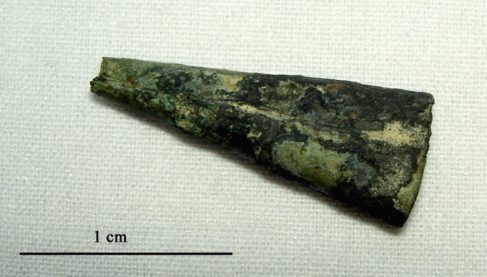CAPTION
These small, delicate objects don’t look like much from a distance, yet their role in the lives of the Esopus Indians was one of extreme beauty. These tiny pieces of shiny copper, rolled into cones called tinklers, attached to women’s dresses during ceremonial dances, tell as much about these Native American people as they do about their relationship with the settlers who entered the land in the 17th century.
DESCRIPTION
The tinklers, once bright and shiny, are now growing speckled with age; mottled with various mossy greens, ranging in shades of dark forest, to emerald, to sandy beige, they seem as much a part of the earth from which they were uncovered as the grass itself. The copper is astoundingly well preserved, considering it’s around 400 years old, dating between 1609 and 1700 A.D. They are small, ranging between 1.5 and 3 centimeters long. Still, the tinklers have maintained the conical shape that made them jingle and gave them their memorable name. These delicate, decorative cones were part of the Late Woodland Period in the Northeastern United States and belonged to the Esopus Indians who roamed New Paltz and the surrounding region.
PROVENANCE
These tinkle cones were found in New Paltz, Ulster County, New York. They date from the Late Woodland Period and were part of the Esopus Indian culture that dominated the region. They are dated between 1609 and 1700 A.D. and are currently housed in the Historic Huguenot Street Visitor’s Center, located in New Paltz, NY.
NARRATIVE:
We approach the scene: on one side of the clearing, Dutch settlers arrange a wide assortment of brass and copper utilities, iron weapons, silver cutlery, blankets, cotton clothing, liquor, and guns. They seem confident, chatting amongst each other, knowing the sale will go well and they will profit, maybe more than they deserve. For them, these objects are commonplace, imported from Europe where the technology has long existed.
Still, there is a slight sense of fear in the air. Since their arrival in North America, the settlers’ relationship with the Native Americans has been unpredictable, largely because of the difference in cultures and a lack of efficient, or in some cases honest, communication. Quietly but purposefully, their trade partner signals his arrival with the snap of a twig: stepping out of the forest, an Esopus Indian. He is tall, strong, with long dark hair and across his sinewy shoulders stretches a dead deer, a peace offering to the Dutch.
Deals are made, objects exchanged, and a part of history is formed. Each side leaves with something new in their pocket: metal utilities that make survival exponentially easier, or a piece of paper that signs away hundreds of acres of land. One of the most important trade items of all, however, was shiny, malleable copper. This element, never before used by the Esopus Indians, provided a variety of new utensils, weapons, and decorative accessories that could be easily made or altered. While projectile points and pots were essential to the Esopus way of life, one surprising object of a different nature survived 400 years to be found in New Paltz, NY. This object was the tinkle cone.
Tinkle cones, or tinklers, are small pieces of copper rolled into the shape of a cone. When attached to dance and ceremonial clothing, these cones created a melodic jingle, the perfect accompaniment to the drums, rattles, and custom songs of the Esopus. The women, tinklers sewn into their dresses and dangling from their ears, swayed their bodies and reached down towards the ground, thanking the earth that sustained them.
While the Esopus culture was tragically maimed during the increasing settlement of the land, their delicate copper accessories, then a bright metallic orange, survived the test of time to inform later generations of the people that once lived in the area. Now, like the earth that played such a crucial role in the lives of their people, the tinkle cones are a beautiful, natural green.
Sources
Kraft, Herbert C. The Lenape-Delaware Indian Heritage; 10,000 BC to AD 2,000. N/A: Lenape Books, 2001. Print.
Kraft, Herbert C. The Lenape Archeology History and Ethnography. Newark, NJ: New Jersey Historical Society, 1986. Print.

I love this, its so cool! it would be really interesting and nice if you could add more on how these were used for dances. like what types of dances these were used for and even a picture of how it was used would be awesome! was it really difficult finding information on these? Were the Esopus Indians the only culture/ group that used these tinkle cones? Are they only found in this New Paltz area? 🙂
I really enjoyed your post, especially since I am doing Native American history as well. Interesting parallel you made with the Tinkle cones resembling nature.